No need for skepticism
The New Shim-pack Scepter columns for LC/LCMS are robust and extremely pH-stable
Dr Carola Thiering, Shimadzu Europa GmbH
The new Shim-pack Scepter columns with hybrid materials combine the advantages of silica- and polymer-based columns: they are efficient, pressure-stable and tolerate broad pH ranges. They are also available as metal-free versions for sensitive LC/MS measurements of biological samples or chelating substances.
»The chromatographic column is a high-tech product and not a tube filled with sludge.«
Klaus K. Unger, Stefan Lamotte: „Chromatographie: Trennsäulen in der analytischen HPLC“ [1]
»The chromatographic column is a high-tech product and not a tube filled with sludge.«
Klaus K. Unger, Stefan Lamotte: „Chromatographie: Trennsäulen in der analytischen HPLC“ [1]
Rather, it is the core of an analysis, along with the eluent, and specific columns are offered depending on the goal of the analysis. Interdisciplinary knowledge flows into the construction and packing of these columns; their selectivity, for example, depends on numerous material and process parameters.
To support optimal performance interaction of all parts of an HPLC system, seamless quality and transport chains are especially important in high-tech applications. Shimadzu users benefit from single-source supply and coordinated components and processes. Consequently, accessories and consumables are an integral part of a complete solution from Shimadzu.
Thanks to a new series of LC columns, users get more flexibility. The new columns from the Shim-pack Scepter series are packed with hybrid materials and are available in both metal and metal-free versions. They complement the silica-based, core-shell and polymer column portfolios and cover a wider range of application needs than before. The main advantages of hybrid materials are their pH stability and robustness. They are also available in a broad spectrum of particle sizes and dimensions, making them scalable from UHPLC to HPLC and preparative LC.
Organo-silica hybrid columns
But what exactly is organo-silica hybrid material? The particles are organic/inorganic silica-based hybrid materials, or in other words, based on hybrid silica gel (figure 1), using tetraethoxysilane and 1,2-bis(triethoxysilyl)ethane as reactants for their production.
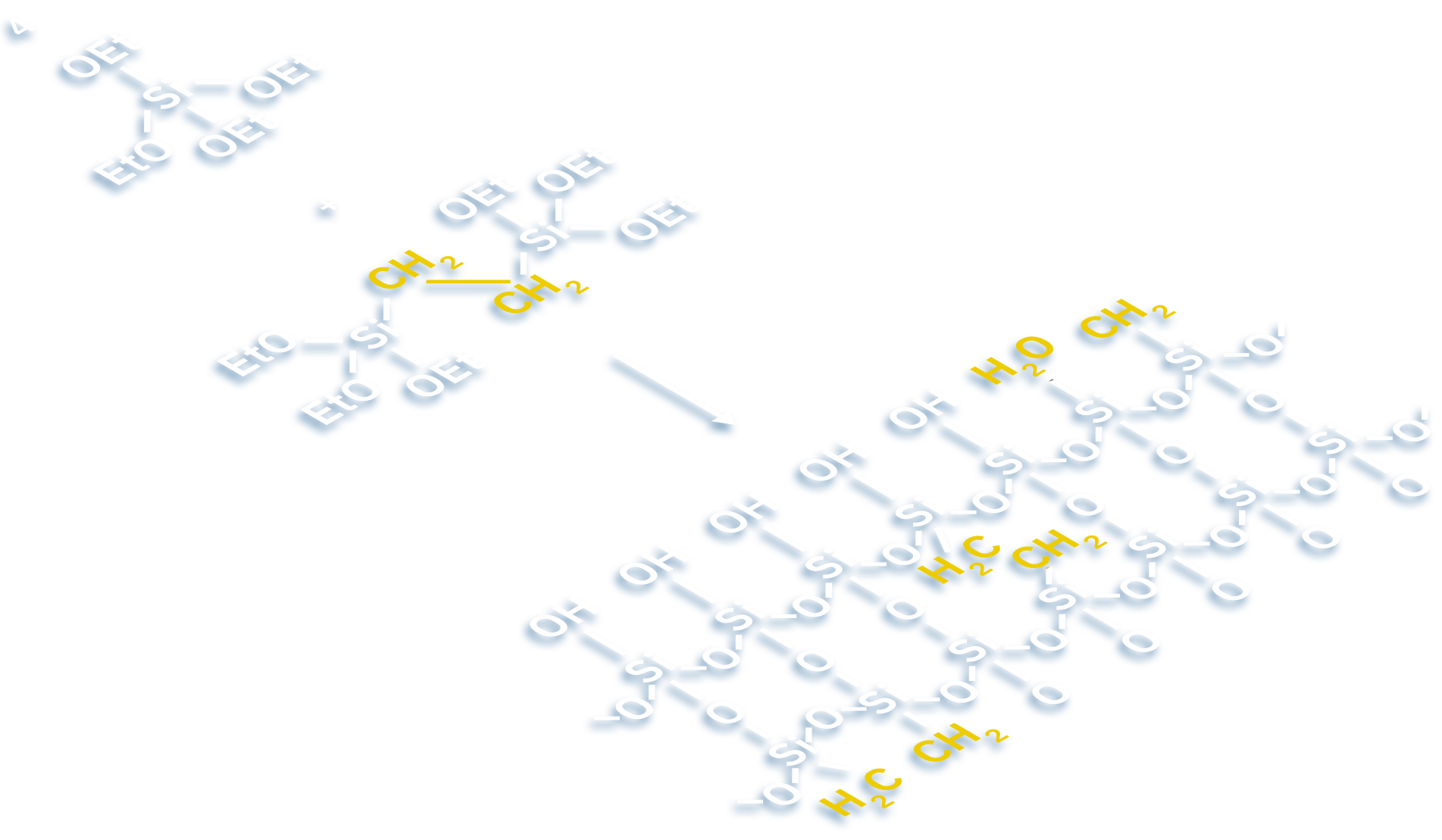
The resulting hybrid material is shown schematically. The upper layer represents the surface, and the lower layer shows the internal structure of the particle. Evidently, the silicon atoms are connected not only by an oxygen atom, but also partly by an ethylene bridge. This combination of silica gel with the organic parts makes the material very robust and pH stable.
The silanol groups on the surface are also partially replaced by an ethylene bridge. The resulting decrease in silanol groups on the surface is largely responsible for the increase in stability and inertness of the silica gel, because it is shielded against exposure to chemicals.
As a result, the hybrid materials are suitable for a wide range of HPLC applications. The advantages are
- high durability, even under harsh conditions such as a high pH-value or high temperature
- general high chemical and physical resistance
- good peak shape for all kinds of compounds, and
- reproducibility.
Selectivity is also the same across different particle sizes, so method transfer between UHPLC and HPLC is very easy. Due to the preparative columns in the portfolio, the method transfer is even suitable for preparative LC.
Easy method transfer; sensitive measurements
Columns with hybrid materials combine the advantages of silica-based and polymer-based columns: they are efficient and pressure-stable thanks to their mechanical stability. Additionally, they have a high tolerance to basic mobile phases and low silanol acidity. [1]
As a further advantage, the Scepter portfolio is also available as metal-free variants, which are very effective for sensitive LC/MS measurements of chelating substances that would otherwise show strong tailing. So, there is no reason to be skeptical – because overall the Shim-pack Scepter columns comprise a large product range and are extremely robust and durable due to the hybrid material.
Shim-pack Scepter portfolio: for numerous applications with diverse substances
The Scepter portfolio covers a wide range of stationary phases and dimensions. For each of these stationary phases, there is an appropriate precolumn with holder. Table 1 shows all of the phases with their respective specifications. Particularly noteworthy are the large pore size of 30 nm for the Scepter C4 column, which is ideal for the analysis of proteins and antibodies, and the wide pH range of 1-12 for the Scepter C18, HD-C18 and C8.
| Shim-pack Scepter | Reversed phase | HILIC | |||||
| C18 | HD-C18 | C8 | C4 | Phenyl | PFPP | Diol-HILIC | |
| Ligand type | Trifunctional C18 | Trifunctional C18 | Trifunctional C8 | Trifunctional C4 | Trifunctional Phenylbutyl | Trifunctional Pentafluorophenylpropyl | Trifunctional Dihydroxypropyl |
| Generic Purpose Type | High Density Type | ||||||
| Particle | Organic Silica Hybrid | ||||||
| Particle size | 1.9 µm, 3 µm, 5 µm | ||||||
| Pores size | 12 nm | 8 nm | 12 nm | 30 nm | 12 nm | ||
| End capping | Proprietary | None | |||||
| pH range | 1 – 12 | 1 – 10 | 1 – 8 | 2 – 10 | |||
| 100% aqueous condition | Yes | No | No | Yes | Yes | Yes | N/A |
| USP classification | L1 | L1 | L7 | L26 | L11 | L43 | L20 |
| Shim-pack Scepter | Reversed phase | HILIC | |||||
| C18 | HD-C18 | C8 | C4 | Phenyl | PFPP | Diol-HILIC | |
| Ligand type | Trifunctional C18 | Trifunctional C18 | Trifunctional C8 | Trifunctional C4 | Trifunctional Phenylbutyl | Trifunctional Pentafluorophenylpropyl | Trifunctional Dihydroxypropyl |
| Generic Purpose Type | High Density Type | ||||||
| Particle | Organic Silica Hybrid | ||||||
| Particle size | 1.9 µm, 3 µm, 5 µm | ||||||
| Pores size | 12 nm | 8 nm | 12 nm | 30 nm | 12 nm | ||
| End capping | Proprietary | None | |||||
| pH range | 1 – 12 | 1 – 10 | 1 – 8 | 2 – 10 | |||
| 100% aqueous condition | Yes | No | No | Yes | Yes | Yes | N/A |
| USP classification | L1 | L1 | L7 | L26 | L11 | L43 | L20 |
Below, the different stationary phases are presented, and the most important properties are briefly explained:
Shim-pack Scepter C18: For substances with medium to high hydrophobicity
This phase is the standard choice for reversed phase chromatography. Scepter C18 has the highest hydrophobic retention in the range. It is suitable for substances with medium to high hydrophobicity. The density of the C18 chains on the surface of the organosilica hybrid particles is lower compared to the Scepter HD-C18 (figures 2 and 3).
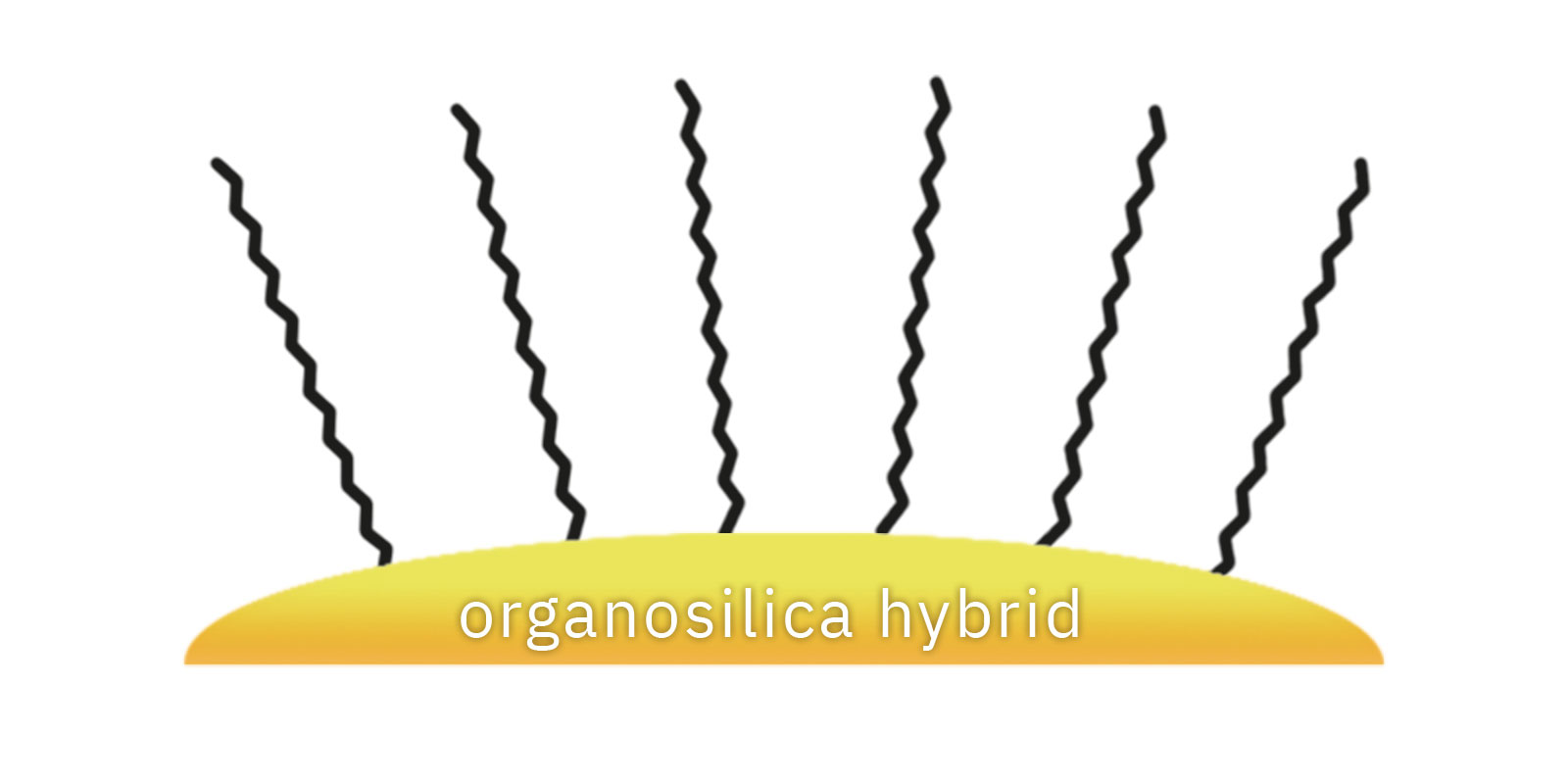
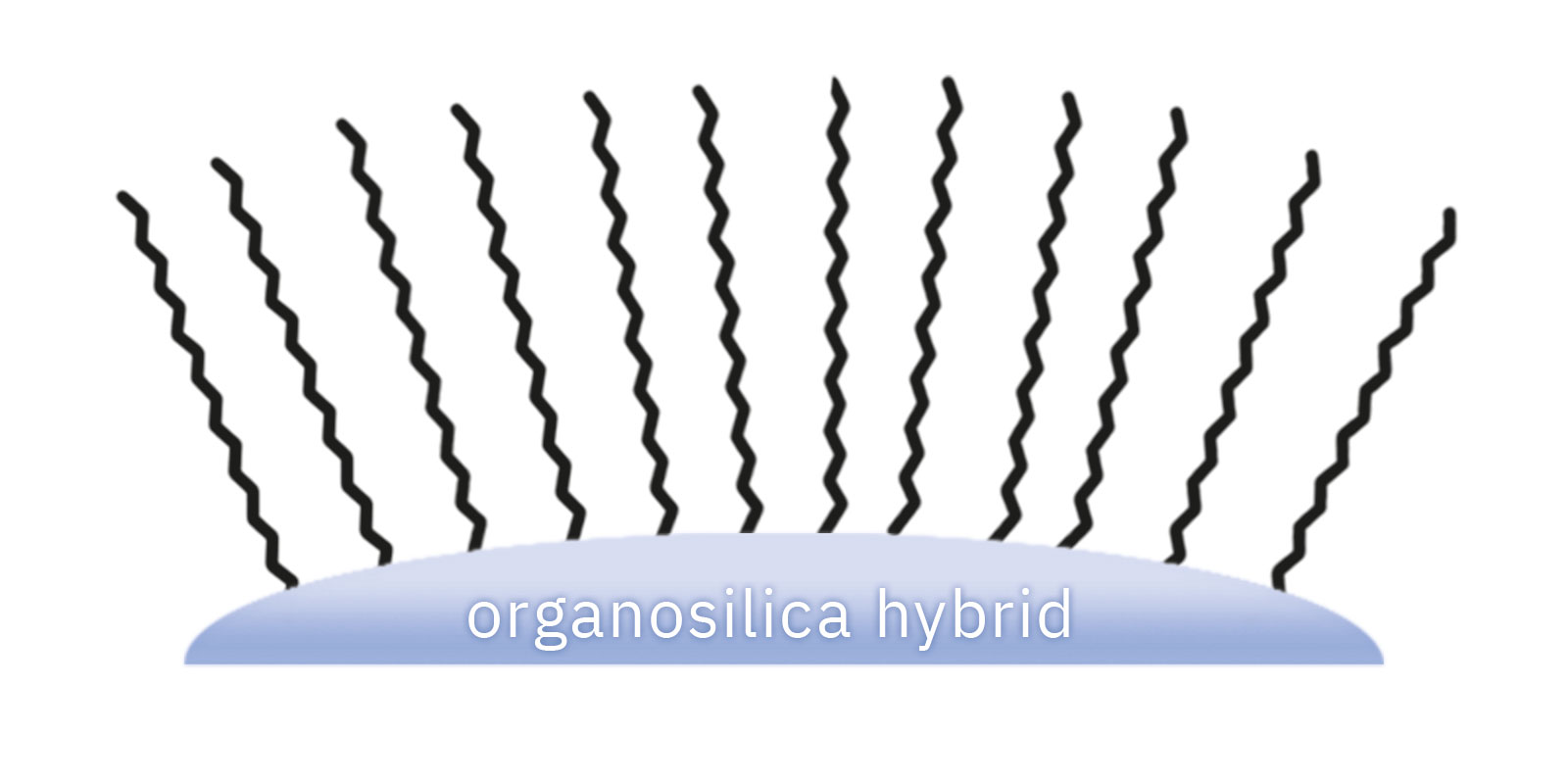
Shim-pack Scepter HD-C18: For molecules with small structural differences
The HD-C18 phase is particularly suitable for separating highly hydrophobic, small molecules with small structural differences – such as isomers. The density of the C18 chains on the surface of the organosilica hybrid particles is higher compared to the Scepter HD-C18 (figures 2 and 3). As a result, molecules that can fit between the C18 chains because of their size, interact more than molecules that cannot or can only partially fit between them because of their molecular structure. This makes it easier to separate molecules with small structural differences.
Shim-pack Scepter C8
This phase is suitable for substances that achieve too much retention on the C18 column.
Shim-pack Scepter C4: For substances with high molecular weight, e.g. proteins
The latest column of the Shim-pack Scepter series features very large pores of 30 nm and is therefore ideally suited for biological samples such as proteins and monoclonal antibodies. Proteins can be analyzed with this C4 phase up to a molecular weight of 150,000 Daltons. Especially for the analysis of antibodies, this column is stable even under acidic conditions and high temperatures. Furthermore, the C4 phase effectively separates very hydrophobic substances that are difficult to separate with the regular C18 column.
Shim-pack Scepter Phenyl: For aromatic, conjugated compounds
Best suited for aromatic, conjugated compounds, as the phenyl group interacts with п-electrons from the substances.
Shim-pack Scepter PFPP: For conformational isomers and halogenated compounds
The abbreviation PFPP means pentafluorophenylpropyl. This group provides alternative selectivity for conformational isomers (cis/trans) and polar as well as halogenated compounds. Additionally, charged bases are more strongly retarded.
Shim-pack Scepter Diol-HILIC: For polar analytes
Diol-HILIC (Hydrophilic Interaction Chromatography) can be used to retard polar analytes. The chemical composition of the stationary phase is pure silica. MS sensitivity is increased, for example, by the high proportion of organics that can be used in HILIC mode.
All columns are robust within a wide pH range. The chromatograms in figure 4 (measurement parameters and methods are explained below) demonstrate this stability. Results of the analyses on the different, stationary phases are shown in the figure at different pH values (2.9, 6.1 and 9.9).
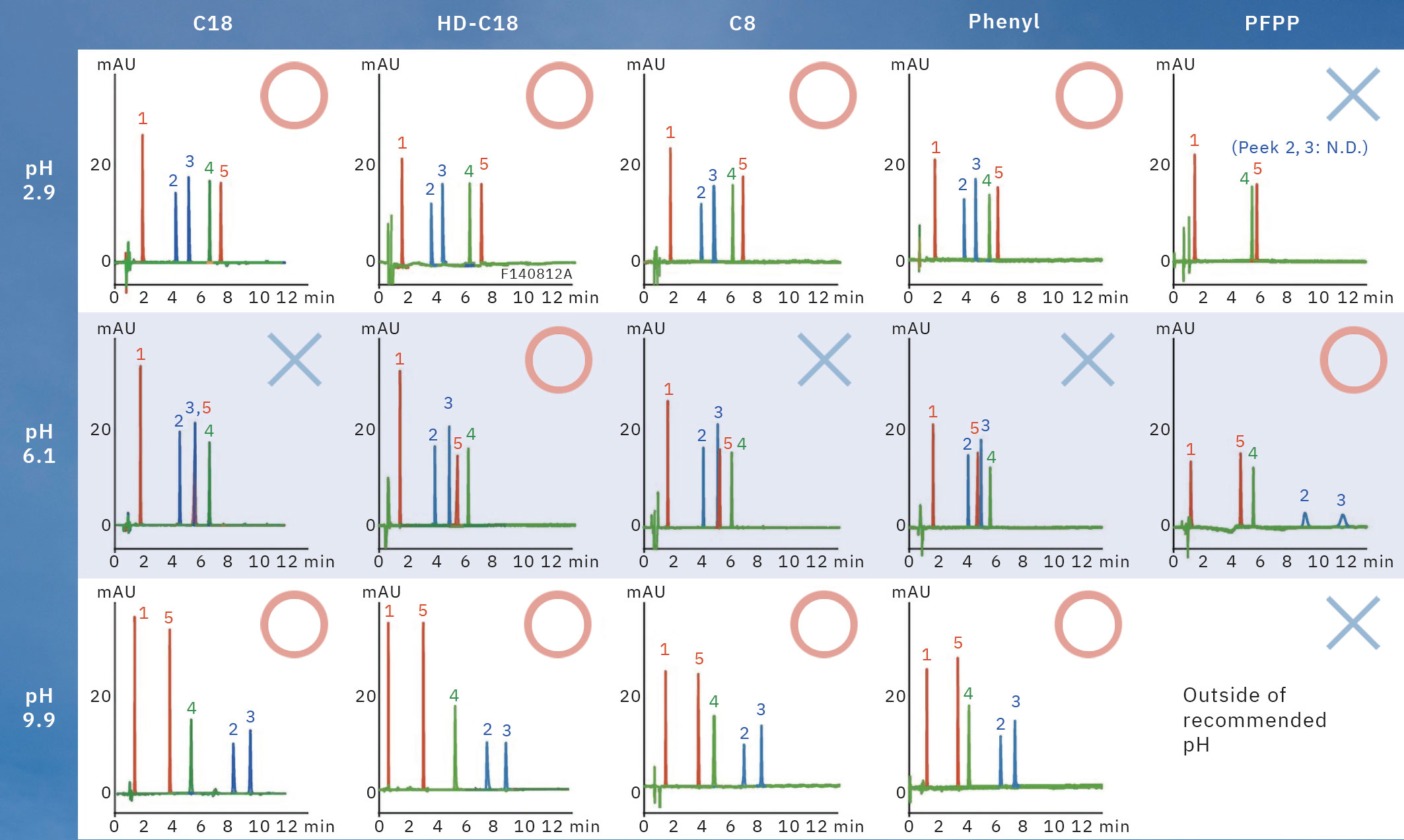
Since the same method is used here for all phases at different pH values, not all substances are always separated optimally from each other. In the chromatograms marked with the red circle, all substances are separated out. The chromatograms with the blue X show coeluting or undeterminable peaks. Overall, it is clear that the columns exhibit high stability at different pH ranges and still have very good separation performance.
The different retention mechanisms also become clear in figure 4: The HD-C18 shows better separation performance than the C18 for critical substances. As expected, the C8 phase shows less retention than the C18 phases, whereas the phenyl and the PFPP phases have completely different separation mechanisms, which partially reverse or strongly shift the retention. In summary, the Shim-pack Scepter portfolio offers the appropriate column for numerous applications with a wide variety of substances.
Measurement parameters and methods
| Columns: | Shim-pack Scepter (50 mm x 2.0 mm I.D., 5 µm) |
| Mobile Phase: | 0.1 min: 95 % H2O, 5 % ACN → 10 min: 10 % H2O, 90 % ACN 10-15 min: 10 % H2O; 90 % ACN |
| Oven Temperature: | 25 °C |
| Flow Rate: | 0.2 mL/min |
| Detection: | 230 nm |
Metal-free columns in the portfolio
The various columns of the Shim-pack Scepter portfolio are also available as metal-free and complete the product range which includes both, the silica gel-based G-series and the organosilica hybrid-based Scepter series.
The schematic structure of the metal-free columns is pictured in figure 5, showing how the particles as filling material do not come into direct contact with the stainless-steel body, due to a coated layer of polyetheretherketone (PEEK). It also affects the connecting pieces of the column, preventing the stainless steel from contacting the sample being examined.
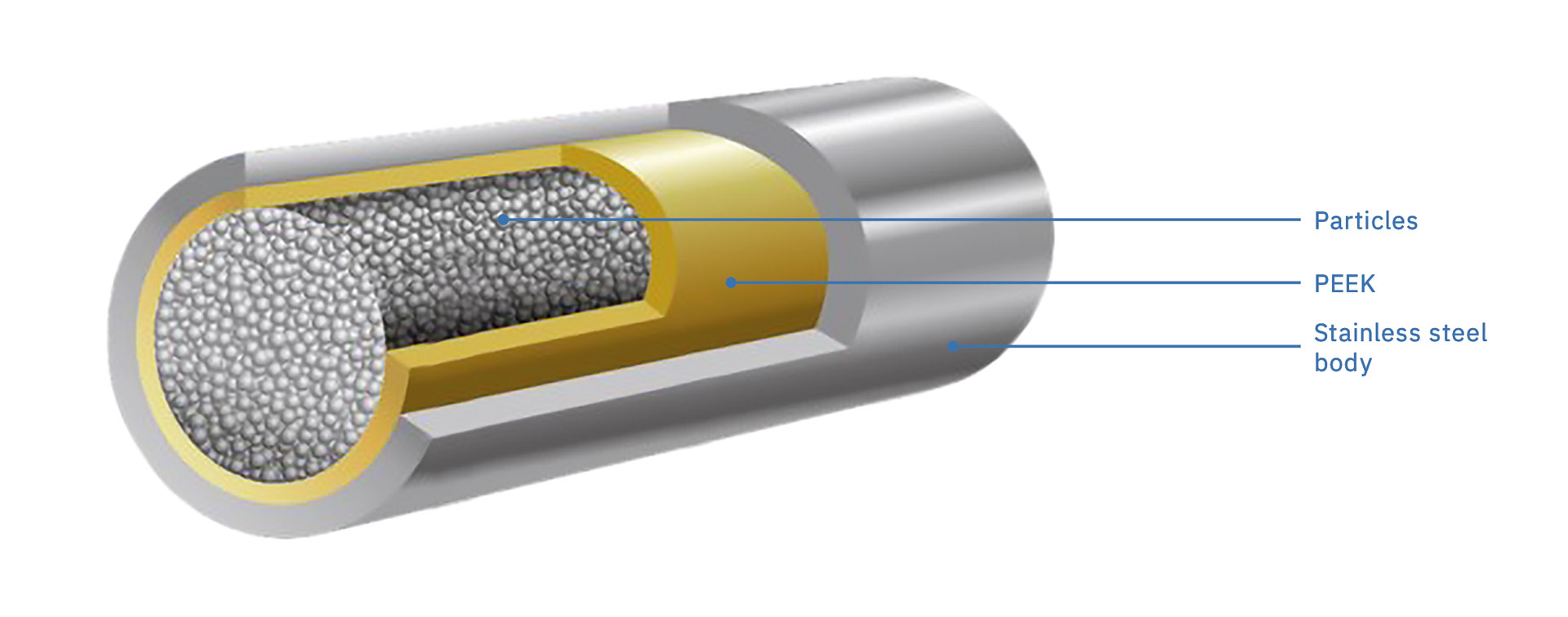
This is a great advantage especially for biological and chelating samples. Such samples interact with metal and would therefore not show a symmetrical peak shape without a PEEK coating, but rather strong tailing, or even a decrease in signal intensity due to adsorption. The combination of stainless-steel body and PEEK coating is ideal: the stainless-steel body is stable and provides the column with high pressure stability, whereas the PEEK coating provides the necessary inertness. The metal-free columns are also very well suited for LCMS analyses and demonstrate high intensity levels.
Application
So, when does it make sense to invest in an HPLC column with hybrid material such as the Shim-pack Scepter? It depends on the application, of course. The Scepter series shows its advantages especially when harsh conditions prevail during the HPLC analysis. It offers stability even at a high pH value and high temperatures. The Scepter columns are also ideally suited for method development or method scaling between UHPLC, HPLC and preparative LC, as they are available in many dimensions and particle sizes while delivering the same separation performance.
Literature
- Unger, Klaus K.; Lamotte, Stefan: Chromatographie: Trennsäulen in der analytischen HPLC; https://analyticalscience.wiley.com/do/10.1002/gitfach.13413